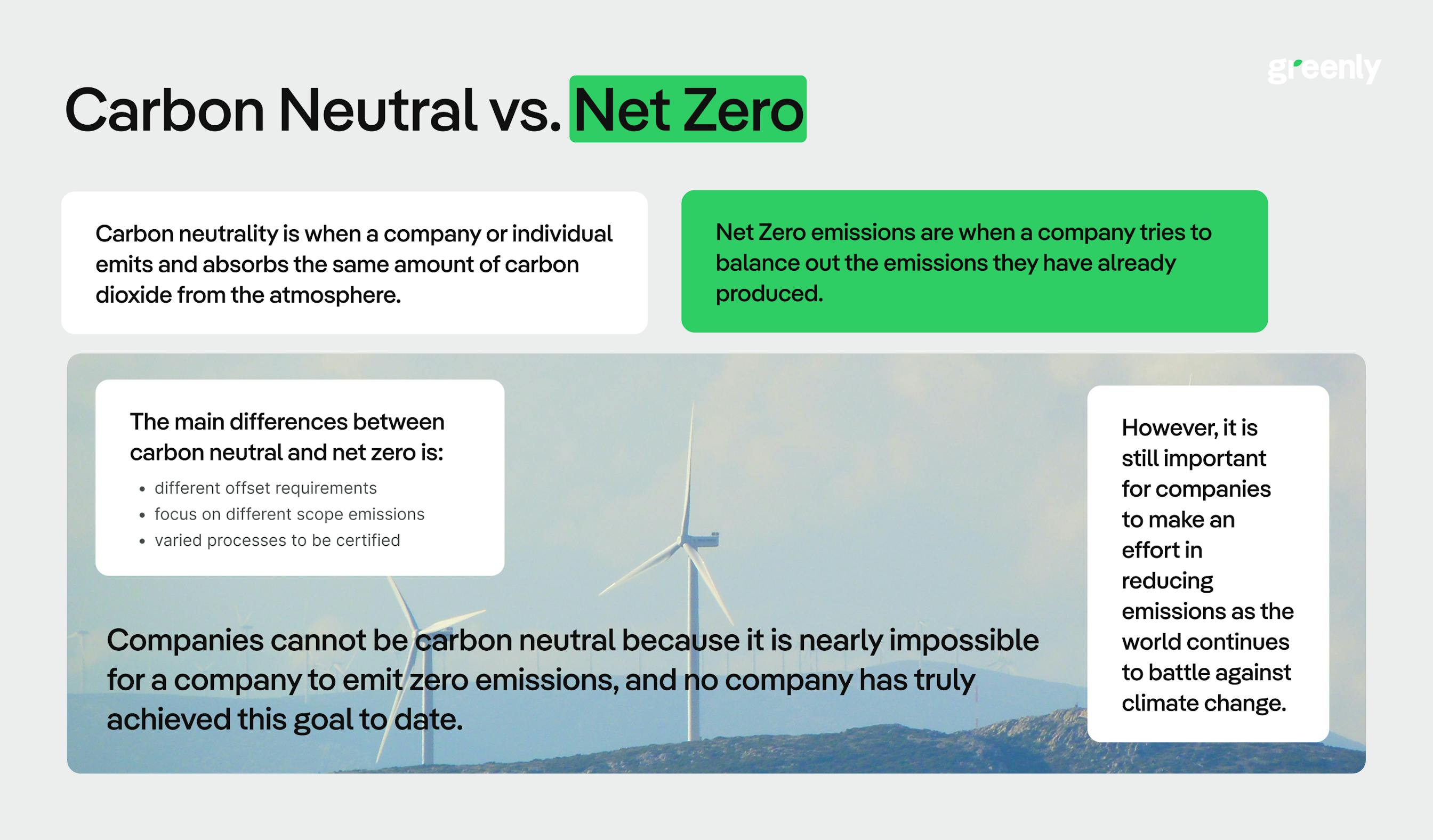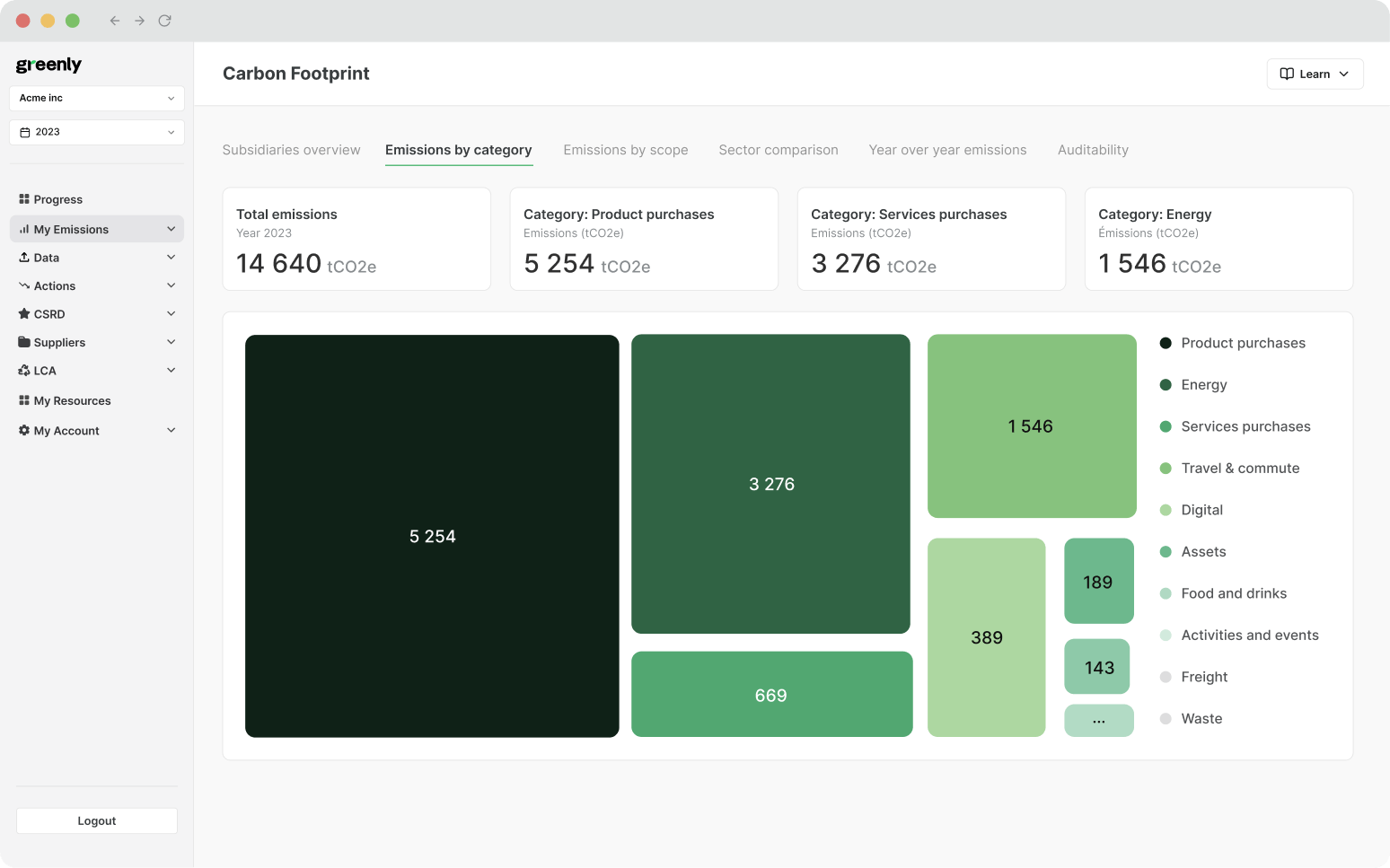
What are the 3 Pillars of Corporate Sustainability?
In this article, we'll explore what the 3 pillars of corporate responsibility are, why they're important, and how businesses can turn them into practical action.
ESG / CSR
Industries



Companies around the world are saying they have achieved carbon neutrality or net zero emissions, but how realistic are these claims?
Several companies have announced misleading goals about carbon neutrality or net zero such as Amazon claiming they'd be net zero carbon by 2040, Microsoft stating in 2020 they'd be carbon negative by 2030, and Apple declaring they would be carbon neutral for supply chain and products by 2030.
However, despite what you’ve heard elsewhere on the web, at Greenly – we’re here to tell you that carbon neutral and net-zero are global objectives, and that no company can ever claim to have achieved either of these.
In this article, we'll explain the difference between carbon neutral vs net zero, the role of carbon offsets and carbon offsetting, and what would happen to the world if we reached net zero on a global scale.
Carbon neutrality and net zero refer to the same concept – a scenario where there is a balance between the emissions produced and the emissions absorbed. These are exclusively global goals that no individual company can achieve independently.
The term carbon neutral is often misused to describe a company that works to offset the same amount of carbon or greenhouse gases that it emits. In reality, carbon neutrality is a global objective where emissions produced and offset are equivalent on a planetary scale. Companies can only play a role in advancing this global goal, and can never achieve it on their own.
However, it's important to remember that only working to offset your company's emissions rather than reducing them from the source won’t keep the world under the 1.5°C target, set by the 2015 Paris Agreement.
Remember, it’s impossible to become a carbon neutral company, as no business will ever have full insight on how many emissions they truly produced and therefore – will never be able to be sure if they are entirely balancing their emissions.
Net zero refers to a global state where strategies are employed worldwide to reduce emissions as close to zero as possible, and then proceeding to offset only the essential emissions that remain. Companies can support this global objective but cannot claim to be 'net zero' independently.
Designed as a more comprehensive, long-term global objective – net zero GHG emissions worldwide were developed to keep us on track for a global temperature rise of less than 1.5°C – which is in line with pre-industrial levels.. This can only be achieved through collective global action, not by individual company efforts alone.
However, the problem with net-zero is the same issue presented with claiming to be carbon neutral – companies cannot "reach" these states as they are global objectives, and making such claims could be misleading potential customers and stakeholders regarding their current environmental impact.
Overall, net zero refers to a state where the amount of greenhouse gases going into the atmosphere are balanced by removing that same amount from the atmosphere. It is imperative to remember that no individual company can achieve this balance in isolation – they can only participate in the collective global effort.


At the end of the day, carbon neutral and net zero essentially refer to the same thing – a balance in the emissions produced and removed from the atmosphere. However, net zero is often seen as more aspirational, long-term goal – as it is aligned with limiting global warming to below 1.5 °C.
The table below will further breakdown the differences between carbon neutral and net zero:
| Aspect | Carbon Neutral | Net Zero |
|---|---|---|
| Definition | Achieving a balance between emitting carbon and absorbing carbon from the atmosphere in carbon sinks. Typically involves offsetting emissions by investing in carbon reduction projects. | Reducing carbon emissions to as close to zero as possible and offsetting any remaining emissions. Focuses on reducing emissions through changes in processes and energy use. |
| Approach | Often relies on purchasing carbon credits to offset emissions that cannot be eliminated. | Prioritizes actual reductions in emissions before considering offsets, aiming for minimal reliance on offsets. |
| Scope | Can be applied to specific activities, products, or the entire organization. | Generally applied to the entire organization or country, encompassing all operations and activities. |
| Long-term Goal | Maintaining a balance of emissions through continuous offsetting. | Achieving a state where no net emissions are produced, focusing on sustainable practices and renewable energy use. |
| Measurement | Often measured on an annual basis, with regular offsetting required to maintain neutrality. | Measured as a reduction trajectory over time, aiming for absolute zero emissions as much as possible. |
| Example Actions | Investing in reforestation projects, purchasing carbon offsets, improving energy efficiency. | Implementing renewable energy solutions, transforming production processes, enhancing energy efficiency, and then offsetting remaining emissions. |
| Certification | Carbon neutral certifications are available from various organizations and often involve demonstrating offset purchases. | Net zero certifications require comprehensive emission reductions and are more stringent in terms of allowable offsets. |


Carbon neutrality refers to balancing carbon dioxide (CO₂) emissions by removing or offsetting an equivalent amount from the atmosphere in addition to offsetting any remaining, unavoidable emissions. This term is misleading when applied to companies because it incorrectly insinuates they can achieve this balance independently, rather than aiding in the overall global effort.
However, it is important to note that carbon neutrality is not an end goal and goes beyond just carbon neutrality – as it doesn't reverse environmental damage already created. Developing a truly sustainable world would require additional efforts such as a long-term transition to more sustainable practices that would evade the need to reduce or compensate for these excess emissions in the first place.
No company can ever be carbon neutral, as GHG accounting, no matter how precise, is still subject to uncertainty – making it impossible for any company to be entirely sure that they are balancing out all of the emissions they emit.
Furthermore, it is important to remember that seeking to create a balance of emissions produced and absorbed doesn't inherently mean that all of their business practices are the most sustainable or that a carbon neutral product is the most eco-friendly choice.
Remember, the term carbon neutral can often be misleading – as it doesn't change the fact that the products may be made with non-renewable resources or high polluting raw materials.
This is why carbon neutrality can sometimes be considered as a form of greenwashing, as it does not demand companies to make deep, systemic changes to their operations.
Overall, a company can contribute to carbon neutrality on a global scale – but it can never achieve carbon neutrality by itself.
Think of the concept of world peace: France may want world peace, and establish peace in their own country – but it doesn’t stop the other 194 countries in the world from engaging in a war. France will have done their part to contribute to world peace, but they can’t say they’ve achieved world peace – and the same goes for companies claiming to have achieved carbon neutrality.


No company can ever be carbon neutral, but all companies should still make an effort to avoid increasing their emissions and actively work towards reducing their existing carbon or GHG emissions.
In the same way that a company cannot be carbon neutral, a company can also only contribute to the global objective of net zero – as opposed to claiming it is a net zero company on its own.
In practice, most companies will work towards this goal by first cutting down on unnecessary emissions to reduce their carbon footprint, and then offsetting what’s left – such as by purchasing carbon offsets.
However, this in of itself is part of why no company could ever be fully carbon neutral.
This is because a company could technically not even try to reduce their greenhouse gas emissions, pay for the equivalent amount in offsets, and call themselves "neutral" without ever making an effort to reduce their already existing emissions from the source.
It’s good to reduce emissions from the source and offset the additional, more challenging emissions to reduce – but companies shouldn’t label themselves as carbon neutral, as it’s impossible to be a carbon neutral company and can prove misleading to customers and stakeholders.

There are different international standards and certifications to demonstrate a company's commitment to contributing to carbon neutrality and net zero.
However, it is important to remember that these standards are a useful tool for companies to understand how they can align themselves with the global objective of net zero – but they do not perfectly align with the true definition of carbon neutrality.
You can be certified as contributing to the global goal of carbon neutrality if you adhere to the standards outlined by PAS 2060. This certification is the international standard for contributing to carbon neutrality. To qualify for this standard, companies must:
Currently, you can become PAS 2060 certified through organizations such as Control Union, Carbon Trust, and NQA.
Meanwhile, in October of 2021 (just in time for COP26), the SBTi released their Net-Zero Standard, designed to help companies set science-based targets to contribute to net zero by 2050.
This standard (Science Based Targets initiative) has four key requirements:

If the world were to reach net zero on a global scale, the only scale at which net zero is possible, climate models foreshadow that global warming would come to a stop – as the amount of carbon dioxide emitted by human activities would finally be equivalent to the amount of CO₂ from the atmosphere.
However, a paper written by 21 climate experts delineates while it’s true that temperatures would finally stabilize and decrease the impending doom of various natural disasters such as hurricanes, sea-level rise, and more – reaching net-zero on a global scale would still only be the start of learning the mitigate the severity of the long-term impacts of climate change.
This is because while temperatures would be stabilized, our global surface temperature is still subject to change – which could make it challenging for us to maintain global net zero CO2 emissions.
Here are some other reasons why reaching net zero wouldn’t mean the end of fighting against climate change:
Regardless of this challenge to reach net zero on a global scale, there would still be numerous benefits if we accomplish this worldwide effort together – such as via the following:
Ultimately, while some long-term climate processes are bound to continue – achieving net zero on a global scale will allow for various benefits including temperature stabilization, health improvements, and economic opportunities.
Overall, reaching net-zero CO₂ emissions is pivotal to halt global warming and mitigate climate-related risks – and since no company can achieve net zero or carbon neutrality on their own, we must all work together to reduce our emissions on a planetary scale to make a true difference.
If reading this article about carbon neutral and net zero has made you interested in reducing your emissions further, Greenly can help you!
At Greenly we can help you to assess your company’s carbon footprint, and then give you the tools you need to cut down on emissions. We offer a free demo for you to better understand our platform and all that it has to offer – including assistance with boosting supplier engagement, personalized assistance, and new ways to involve your employees.
Click here to learn more about Greenly and how we can help you reduce your carbon footprint.
